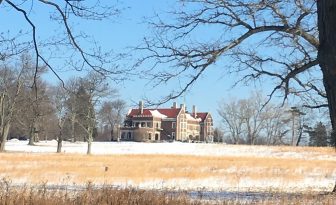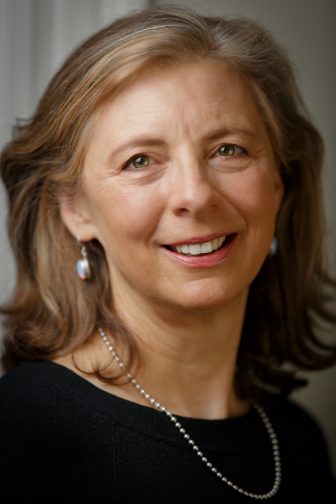A nonprofit organization dedicated to historic preservation in New Canaan is hiring a Pawtucket, R.I.-based firm to put together an application to list one of the town’s most cherished properties on the National Register of Historic Places.

Waveny on Jan. 9, 2017. Credit: Michael Dinan
It isn’t clear yet just which buildings or portion of the grounds at Waveny—beyond the 1912-built main house—will be included in the application that Public Archeology Laboratory Inc. is to prepare, according to Rose Scott Long, co-president of the New Canaan Preservation Alliance.
If approved, Waveny will become the first public property in New Canaan to be listed on the National Register of Historic Places. The town three years ago voted to back the Preservation Alliance in pursuing the listing.
The listing itself has absolutely no bearing on what the town does with main house, grounds or any outbuildings. In addition to creating a special designation for Waveny itself, essentially declaring it a national treasure, the listing’s major benefit is in creating a single document where all historic research related to Waveny will be compiled and made available to the public, Long told NewCanaanite.com.
“It creates a great research tool not just for our community but beyond our community,” Long said.

Virginia Adams
The all-volunteer Preservation Alliance in the three years since the town voted to back its effort has been compiling the RFP for the work about to get underway and also won a state grant to pay for about half the estimated $30,000 cost to create the nomination.
The Public Archeology Laboratory, or ‘PAL,’ itself a nonprofit corporation, was selected from among 20 qualified consulting teams, according to the Preservation Alliance. PAL has successfully completed more than 3,500 projects in areas such as historic preservation planning, and in 2010 prepared the nomination listing 12 New Canaan “moderns” to the National Register.
Its team will be led by Virginia Adams, a senior architectural historian. According to the Preservation Alliance, she “has assembled a team to include: a landscape historian, as the landscape and gardens were designed by the world-renowned Olmsted Brothers; an interiors historian as the interior decoration and furnishings were designed by the prestigious Albert Herter and Herter Looms; and an architectural historian as the mansion was designed by the eminent William B. Tubby, NYC architect.”
The Preservation Alliance is asking for anyone with “materials, maps, or documents pertinent to the history of Waveny” to share them with the consultant, either through Long or chairman emerita Mimi Findlay, who can be reached at newcanaanpreservationalliance@yahoo.com.
The nomination is to be presented to a State Review Board in early summer, following a preview in May at the Preservation Alliance’s annual meeting. Both will be open to the public.
Once the listing is completed, its contents will form an important resource for the town, Long said.
“Moving forward, the information that the consultant will bring together in their research will facilitate future projects, both landscape-wise and structure-wise, but it does not dictate anything,” Long said. “It is just information to facilitate.”
Here’s a history of history of the present-day Waveny Park property, from Findlay:
Waveny Park encompasses the planned landscape of the first resident, Thomas Hall, and later of the second resident, Lewis Lapham and his children, as an “American Country Place.”
The Hall Era: Thomas B. Hall, President of the American Hide and Leather Co[1], in 1895 purchased the 90-acre farm of the 18thcentury Elisha Leeds, creating the winding driveways and stone gateposts that remain today. He built a three-story Dutch Colonial residence with views over Long Island Sound. Over the years Hall added acreage, planted orchards and gardens and farmed. He erected numerous outbuildings including a carriage barn, an ice house to store blocks cut from the pond, a stone water tower, a superintendent’s cottage on the foundation of the Leeds’ farmhouse, and a power plant that ran on coal shipped by rail to the Talmadge Hill siding and then hauled to the farm in wagonloads. [2][3]
The Lapham Era: In 1904 Lewis H. Lapham purchased the property from Hall. He was the son of Henry G. Lapham, a colleague of Hall’s in the leather business, preparing to establish the United States Leather Company when he died in 1888. Lewis Lapham immediately hired the Olmsted Brothers, successor firm to Frederick Law Olmsted, to assist in the siting of a new residence to be designed by Brooklyn’s renowned architect, William B.Tubby, now living in Greenwich, and to create a grand landscape with gardens, terraces, small decorative garden structures, and an area of farm buildings.
Correspondence, In the National Park Service’s Olmsted Archives in Brookline, MA, there are over 100 letters between the firm and the Laphams, documenting the interaction between Lewis and Antoinette Lapham and the Olmsted Brothers firm, starting with John Charles Olmsted, who hadattended the Sheffield Scientific School Yale University, who tried in vain to convince the Laphams to adopt scientific farming methods, breed special animals and plants, and practice “Aesthetic forestry.”
As the new house progressed from 1911 to 1917, the Olmsted firm sent several landscape architects of great talent and national reputation,Percival Gallagher, trained as an artist, and A. Chandler Manning, a horticulturalist, to work with Antoinette (Dearborn) Lapham, on the Waveny plantings and landscape. She was a founding member of the New Canaan Garden Club and also the national treasurer of the YWCA during World War I.
At the urging of son Jack, a polo field was installed by 1915 and at least 50 acres of lawn became an informal putting green and driving range for his father.
It is possible that Waveny’s landscape and gardens were photographed by Frances Benjamin Johnson, pioneer in photographing gardens during the American Country Place Era (1909-1927).
When the Merritt Parkway was designed, the Olmsted firm returned to mitigate the effects on the Lapham property, which was to be transversed. A tennis court, a polo field, and a tennis court were incorporated into the landscape design over the years.[4]
Ruth Lapham Lloyd, married Samuel R. Lloyd in 1924, had seven children and moved into Waveny mansion in 1940, when her mother moved into the Bungalow, Lewis H. Lapham having died in 1934. One of her children was Emmy-Award winner Christopher Lloyd, the actor. After Mrs. Lapham had moved to California and then died in 1956, Mrs. Lloyd was the inheritor of the property. By 1967 she had given two parcels of land to the Town of New Canaan for a new High School and then made Waveny, including the mansion, available to the town for purchase. Subsequently, she became a benefactor of the Metropolitan Museum, establishing an endowment to keep it open to the public on Thursday nights.
Ruth Lloyd’s brother, Roger Lapham, was Mayor of San Francisco. His grandson is Lewis A. Lapham, writer, author of numerous books on politics and current affairs, was editor of Harper’s magazine until 2006 and founder of Lapham’s Quarterly, a new journal about history.[5]
Significance: The buildings and landscape are of state and probably national significance, designed by prominent architects and landscape architects to create an “American Country Place”. In addition the individuals involved in the history of the property also have state and national significance as entrepreneurs, as participants in the early 20th century women’s movement, as politicians, actors and writers.
[1] Chicago Securities, Vol. 18
[2] Carol Valentine http://www.newcanaandarienmag.com/n/July-2008/The-Magic-of-Waveny/
[3] Lois Bayles, Mary Louise King, and F. David Lapham, The Story of Waveny, New Canaan CT: The New Canaan Historical Society, 1969
[4] Lois Baylis, Mary Louise King and F. David Lapham, The Story of Waveny, New Canaan Historical Society 1969 p.15.
[5] http://en.wikipedia.org/wiki/Lewis_H._Lapham